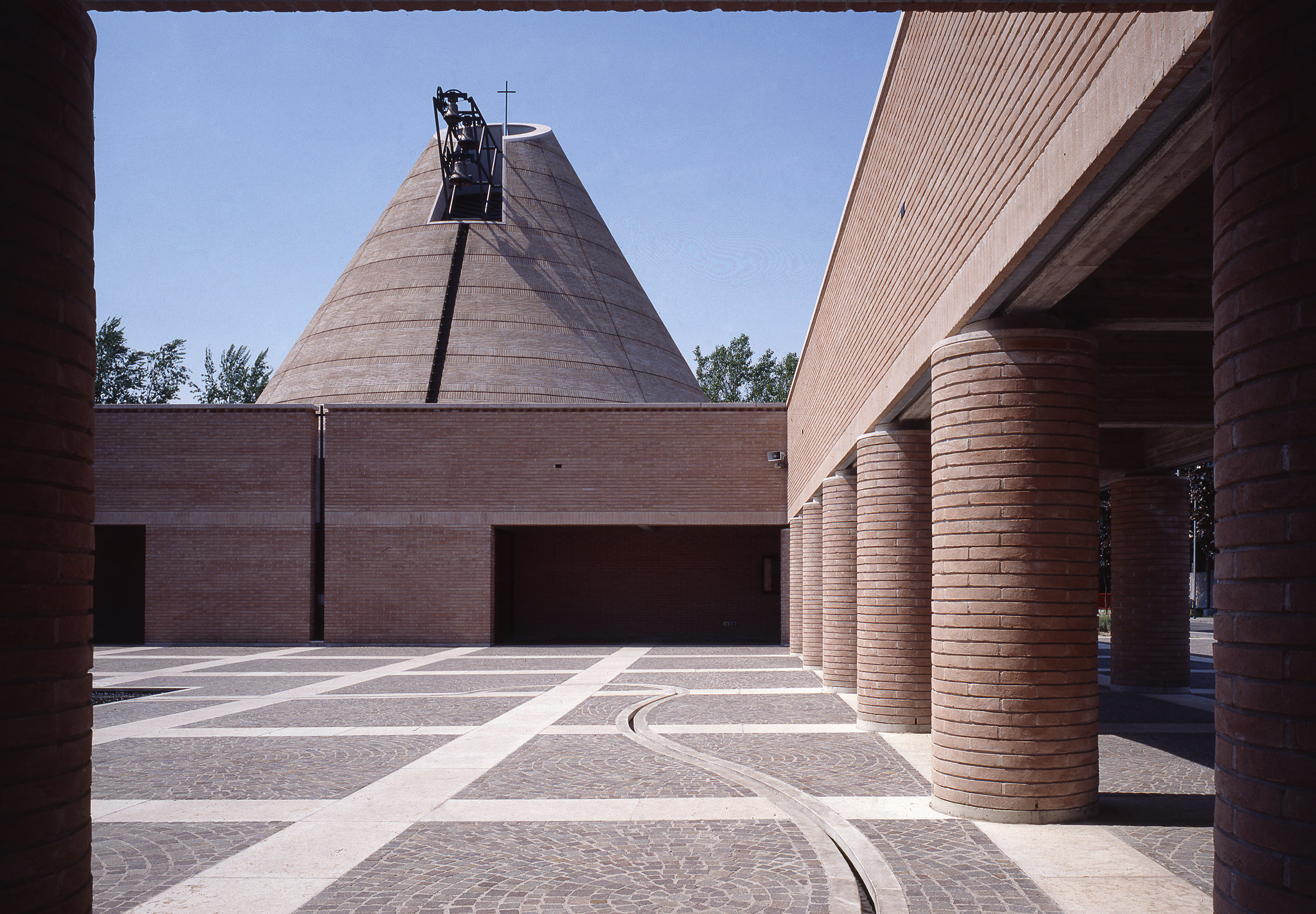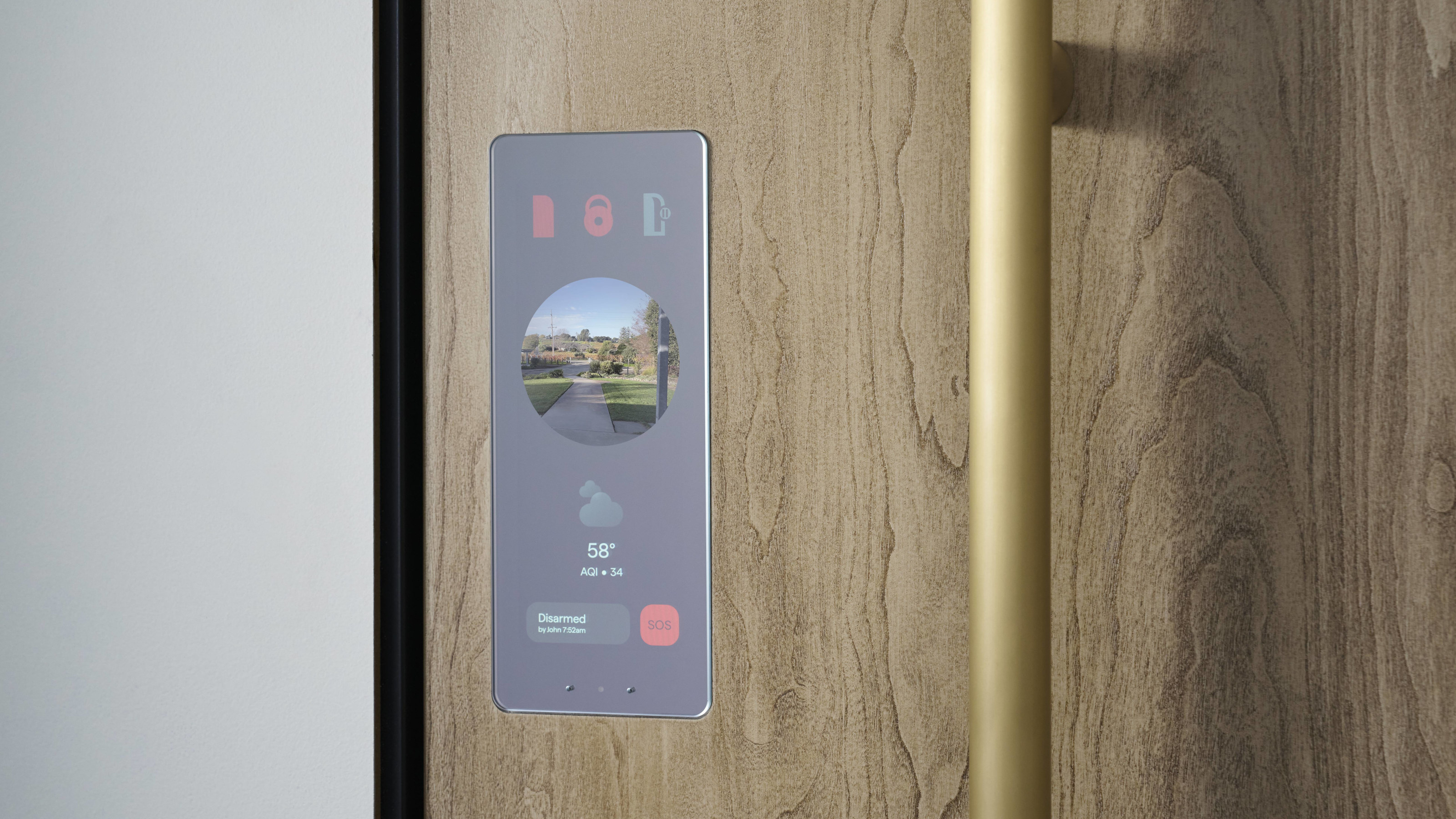Swiss architect Mario Botta’s sacred buildings

The spiritual architecture of Swiss architect Mario Botta is the subject of an exhibition at the Ringturm Exhibition Centre in Vienna. Building studies, drawings and photography are brought side by side to reach an understanding of how Botta conceptualises and designs religious experiences through the built environment.
Religious architecture is a typology that Botta has continued to return to. His very first architectural project was a chapel at the Bigorio Capuchin monastery in Ticino, Switzerland, built in 1966, and since then, he has completed 22 spiritual buildings over his 50 year career.

San Giovanni Battista Church designed by Mario Botta.
The geographical spread of Botta’s spiritual spaces is broad. His chapels can be found across Europe, in Austria, France, Italy and Switzerland. The two vast cylinders and square base of his synagogue in Israel are made of red stone from the Italian Dolomites, while a Swiss timber ceiling lines and softens the interior. Soon his reach will be even wider, as three more of his religious buildings are currently under construction including a mosque in China near the Monogolia border, a Catholic church outside of Seoul, and an Orthodox community centre in Ukraine.
RELATED STORY

Mausoleum of President Patricio Aylwin Azócar, Gonzalo Mardones Arquitecto, Santiago, Chile
While each is unique, his religious buildings hold certain stylistic similarities. Botta plays with heaviness (and lightness) using materials to create experiences of contrast – forming finite and infinite sensations. Daylight and shadows are highly controlled, as well as the human pathway through the architecture, tempered by walls, transparency, paths and thresholds. The experience is a shifting journey between states of compression and expression.

Kirche Papst Johannes XXIII designed by Mario Botta.
Botta’s religious buildings often appear like objects in the landscape, like geometric charms or symbols cut out of natural materials. In Seriate, Italy, his Church dedicated to Pope John XXIII (completed in 2004), resembles a sacred pattern or a detail of a relief carving – the building’s solidity is accentuated further still by its singular cladding material of red Verona marble. Completed in 2013, the Granatkapelle chapel in Zillertal, Austria, takes the dodecahedral form of the mineral granite after which it is named. Citing Le Corbusier, Kahn, Michelucci and Scarpa as references, Botta understands how the power of architecture can define a moment, and make a spiritual statement.

Beato Odorico Church, Pordenone, Italy, 1992, designed by Mario Botta

San Pietro Apostolo Church, Sartirana di Merate, Italy, 1995, designed by Mario Botta.

Cathedral of the Resurrection, Évry, France, 1995, designed by Mario Botta

Cymbalista Synagoge and Jewish Cultural Center, Tel Aviv, Israel, 1998, designed by Mario Botta.

Installation of ‘Mario Botta – Sacred Spaces’ at the Ringturm Exhibition Centre.

Installation of ‘Mario Botta – Sacred Spaces’ at the Ringturm Exhibition Centre
INFORMATION
‘Mario Botta – Sacral Spaces’ is on view until 31 May 2019. For more information, see the Ringturm Exhibition Centre website
Receive our daily digest of inspiration, escapism and design stories from around the world direct to your inbox.
ADDRESS
Ringturm Exhibition Centre
Schottenring 30
1010 Vienna
Austria
Harriet Thorpe is a writer, journalist and editor covering architecture, design and culture, with particular interest in sustainability, 20th-century architecture and community. After studying History of Art at the School of Oriental and African Studies (SOAS) and Journalism at City University in London, she developed her interest in architecture working at Wallpaper* magazine and today contributes to Wallpaper*, The World of Interiors and Icon magazine, amongst other titles. She is author of The Sustainable City (2022, Hoxton Mini Press), a book about sustainable architecture in London, and the Modern Cambridge Map (2023, Blue Crow Media), a map of 20th-century architecture in Cambridge, the city where she grew up.
-
 Sculptor Woody De Othello paints a Miami museum red for a show that ‘almost hugs you’
Sculptor Woody De Othello paints a Miami museum red for a show that ‘almost hugs you’The Miami-born, California-based artist opens his first museum exhibition in his hometown as an experiential journey through life and lifeless objects
-
 Alpine A390 GT: French, fast and fun. A sporting EV with a real sense of occasion
Alpine A390 GT: French, fast and fun. A sporting EV with a real sense of occasionAlpine doubles down on its fast electric credentials with the A390 GT, the French performance brand’s largest car to date
-
 Forget smart homes, Doma's 'intelligent' doors open at the sight of a familiar face
Forget smart homes, Doma's 'intelligent' doors open at the sight of a familiar faceYves Béhar and Jason Johnson have founded Doma, a tech start-up dedicated to seamlessly integrating tech into your daily life
-
 A building kind of like a ‘mille-feuille’: inside Herzog & de Meuron’s home for Lombard Odier
A building kind of like a ‘mille-feuille’: inside Herzog & de Meuron’s home for Lombard OdierWe toured ‘One Roof’ by Herzog & de Meuron, exploring the Swiss studio’s bright, sustainable and carefully layered workspace design; welcome to private bank Lombard Odier’s new headquarters
-
 This tiny church in Denmark is a fresh take on sacred space
This tiny church in Denmark is a fresh take on sacred spaceTiny Church Tolvkanten by Julius Nielsen and Dinesen unifies tradition with modernity in its raw and simple design, demonstrating how the church can remain relevant today
-
 Audrey Hepburn’s stunning Swiss country home could be yours
Audrey Hepburn’s stunning Swiss country home could be yoursAudrey Hepburn’s La Paisable house in the tranquil village of Tolochenaz is for sale
-
 Meet Lisbeth Sachs, the lesser known Swiss modernist architect
Meet Lisbeth Sachs, the lesser known Swiss modernist architectPioneering Lisbeth Sachs is the Swiss architect behind the inspiration for creative collective Annexe’s reimagining of the Swiss pavilion for the Venice Architecture Biennale 2025
-
 A contemporary Swiss chalet combines tradition and modernity, all with a breathtaking view
A contemporary Swiss chalet combines tradition and modernity, all with a breathtaking viewA modern take on the classic chalet in Switzerland, designed by Montalba Architects, mixes local craft with classic midcentury pieces in a refined design inside and out
-
 A new village chapel in the Czech Republic is rich in material and visual symbolism
A new village chapel in the Czech Republic is rich in material and visual symbolismStudio RCNKSK has completed a new chapel - the decade-long project of Our Lady of Sorrows in Nesvačilka, South Moravia
-
 Herzog & de Meuron’s Children’s Hospital in Zurich is a ‘miniature city’
Herzog & de Meuron’s Children’s Hospital in Zurich is a ‘miniature city’Herzog & de Meuron’s Children’s Hospital in Zurich aims to offer a case study in forward-thinking, contemporary architecture for healthcare
-
 Step inside La Tulipe, a flower-shaped brutalist beauty by Jack Vicajee Bertoli in Geneva
Step inside La Tulipe, a flower-shaped brutalist beauty by Jack Vicajee Bertoli in GenevaSprouting from the ground, nicknamed La Tulipe, the Fondation Pour Recherches Médicales building by Jack Vicajee Bertoli is undergoing a two-phase renovation, under the guidance of Geneva architects Meier + Associé